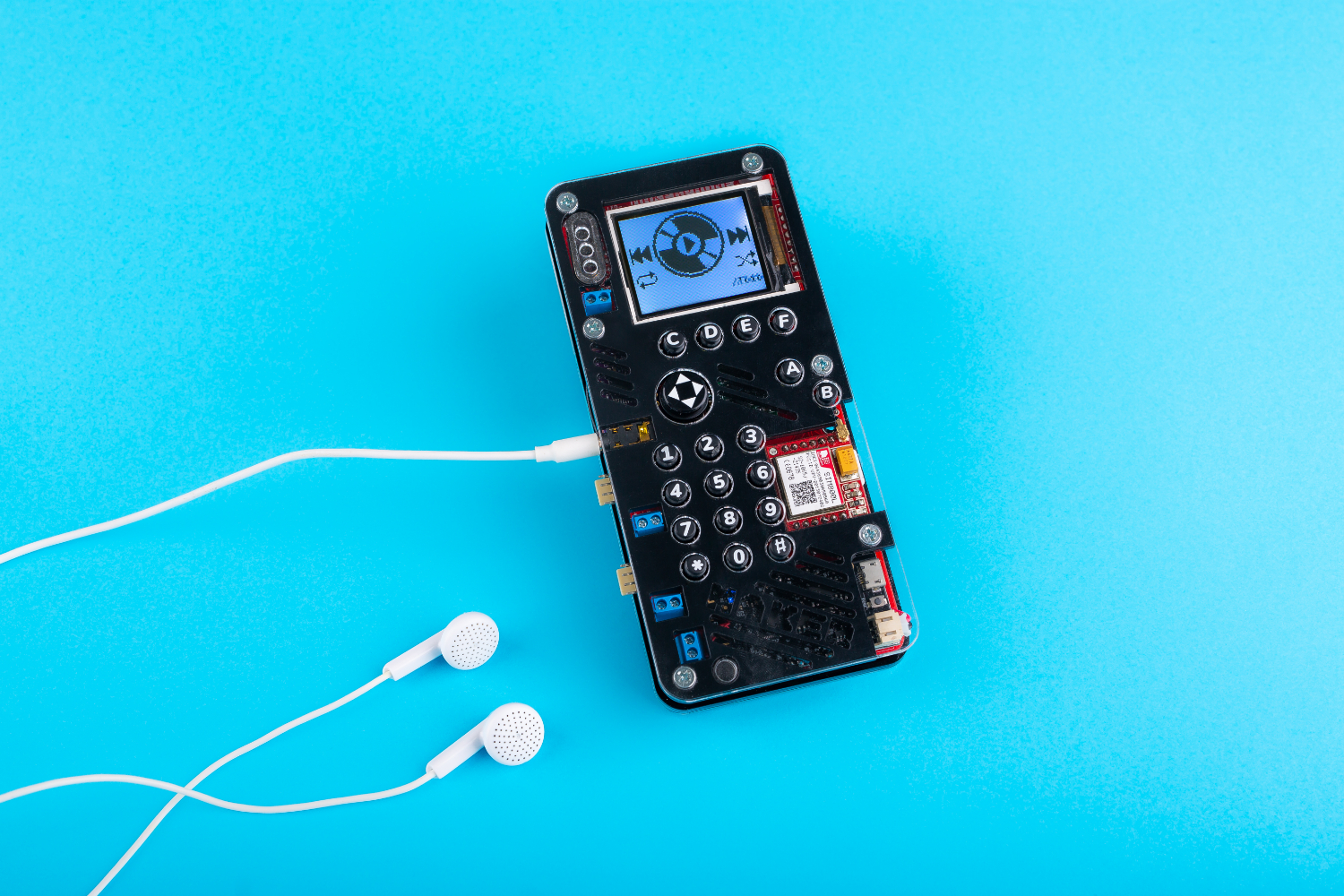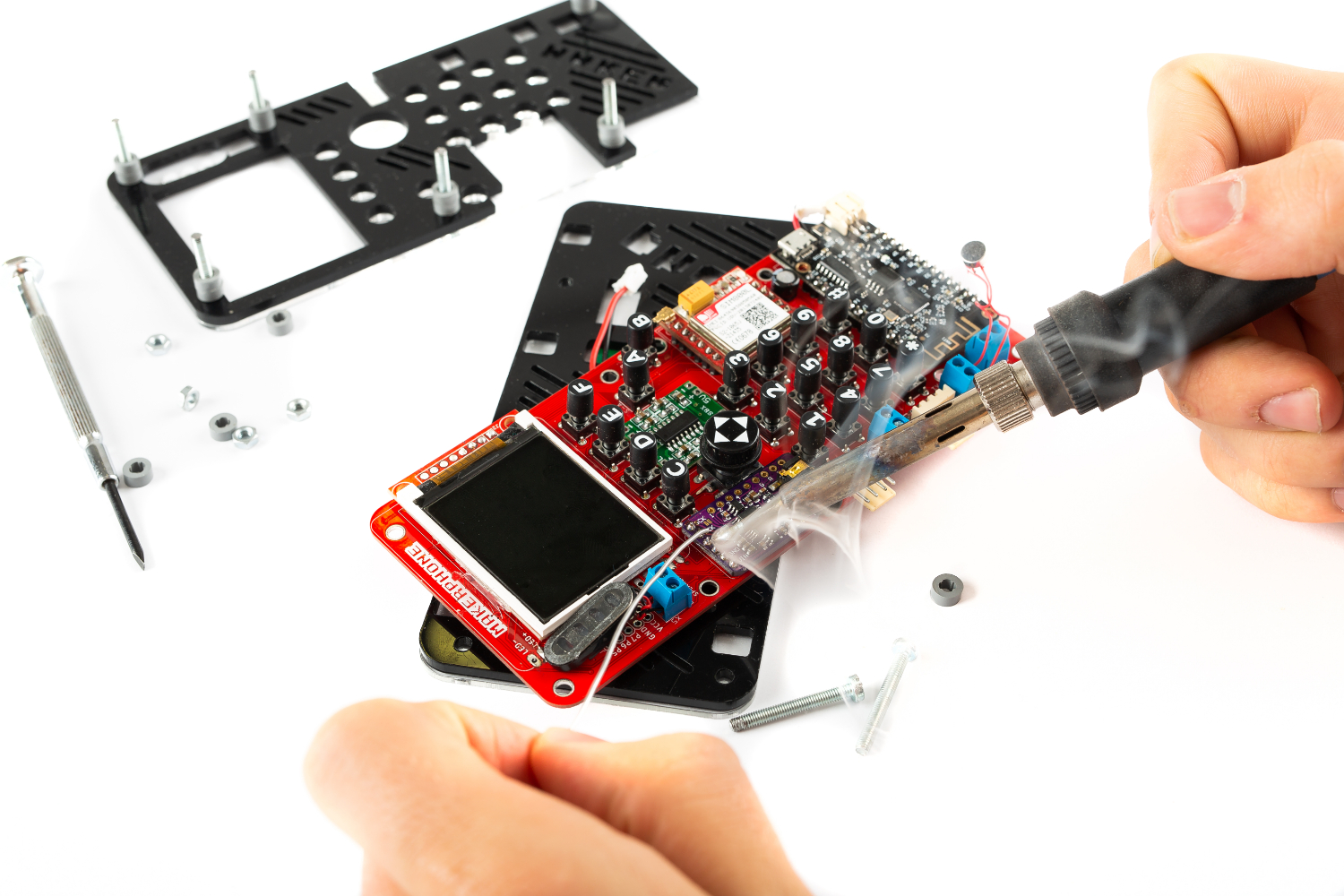Dial Up Your STEM Skills: Inexpensive Kit Lets You Build a Smartphone
Most people carry a smartphone in their hands, but few can say they built their smartphone with their own hands. A Kickstarter with a whopping $251,100 in the bucket as of this writing is selling that experience to makers with MAKERPhone, a DIY smartphone you can build and code to use for phone calls, listening to music and even playing games like Space Invaders. One MAKERphone kit costs $94, and backers worldwide should receive the product by March.
MAKERPhone is a kit with all the components necessary to build a functioning smartphone. When built, it automatically connects to a cellular network after you insert a SIM card.
It’s the second product from Croatia-based start-up CircuitMess (its first was DIY portable video game console MAKERbuino). The company’s goal is to turn consumers into creators.
“What people mostly use their phones for today is for internet chat applications and browsing the web et cetera. MAKERphone cannot browse the web and does not have a Facebook app installed, so you probably wouldn't want to use that as your day-to-day phone (unless you're on some kind of a digital detox program), but that's not the point of this device,” Albert Gajšak, CEO and co-founder of CircuitMess, told Tom’s Hardware.
MAKERphone Kit Specs
| CPU | ESP32 microcontroller with Xtensa dual-core, 32-bit LX6 microprocessor operating at 160MHz and up to 600 DMIPS |
| Memory | 4MB built-in flash 520KB SRAM |
| Display | 1.8-inch, 160x128, 16-bit TFT LCD25-50 frames per secondDigitally controllable backlight |
| Cellular Connectivity | Standard version: 2G GSM chipset (SIM800 chip)4G version: 4G chipset (SIM7600 chip) |
| Network Connectivity | Wi-Fi 802.11 b/g/nBluetooth v4.2 BR/EDRBLE |
| RGB | 8 individually programmable RGB LEDs |
| Audio | 1W speaker10-bit dedicated DAC (PCM5102)Multi-channel MP3 playbackPT2257 (dedicated electronic volume controller) |
| I/O | 3.5mm audio jackMicro SD card Micro SIM card |
| Programming Language Compatibilities | ScratchPythonArduino IDE |
| Color Options | Black, White, Wood, Yellow, Blue, Orange, Red |
| Required Assembly Tools | Soldering ironSolderDiagonal pliersScrewdriverElectrical tape |
MAKERphone takes about 7 hours to build and teaches makers 11 years and older about basic electronics, soldering, resistors, physical computing and how smartphones work, as well as Scratch, Python and Arduino coding (based on C/C++). Its has an acrylic casing and comes with a stick-on antenna to boost phone service. The kit also includes a 128MB SD card pre-loaded with compatible games and apps, including Contacts, SMS, a dialer, an MP3 player and “Game Boy-inspired games.”
Since the Kickstarter has surpassed its minimum goal, CircuitMess is able to offer backers its custom-made ringtones, a new game, which will be picked based on backers’ votes, and a wireless multi-player function.
And you can be a part of the RGB trend with MAKERphone too. Its 8 LED lights are programmable for app-related effects, like turning red when you’re dying in a game or illuminating when you need a flashlight.
Get Tom's Hardware's best news and in-depth reviews, straight to your inbox.
To keep the fun going, CircuitMess also partnered with IoT modular hardware vendor NCD for plug-and-play add-on modules, including sensors, controls and monitoring devices, which will be available at extra cost after the Kickstarter closes.
Coding With MAKERphone
CircuitMess breaks the MAKERphone learning process into eight steps:
- Learning about the kit
- Learning electronics basics (electrons, components)
- Learning about the tools
- Making the MAKERphone
- Making a Scratch-based app
- Making a Scratch-based game
- Coding with Python
- Coding with Arduino
In addition to the included apps, MAKERPhone lets you make your own apps and games, like Pong and Snake, with Scratch, which is especially kid-friendly and uses a drag-and-drop system with blocks to teach.
The next step up is programming with MicroPython, a scaled down version of the Python 3 programming language.
More advanced makers can program the smartphone’s microcontroller with Arduino IDE, which is based on C/C++. The smartphone is compatible with “most” online Arduino software libraries and can work with Arduino shields and modules with little to no code tweaking, the company says.
After making your app, you can put it in an executable binary file and then on the included SD card so it can live in the phone’s Apps menu.
In addition, CircuitMess offers an open-source programming library to help users create GUI-related content, sounds, music and animated bitmaps and control the MAKERphone’s hardware. Users can post their apps onto the library, which also includes MAKERphone tutorials.
MAKERphone’s Successful Kickstarter
MAKERphone is an example of successful DIY funding. Its Kickstarter ends on November 22, but it has already greatly surpassed its $15,000 goal. Pledges range from $5, which mostly gets you a thank you, to $4,399 or more for 30 kits, extra button caps and chassis in various colors and components, educational materials and a branded backpack.
CircuitMess still has time to meet its final stretch goals, $250,000 and $300,000, at which point it will introduce new features. The Kickstarter page keeps these potential rewards a mystery, but we were able to get some clues from Gajšak.
“We are not completely sure and are still tinkering [with] this, but some cool ideas that we might offer as stretch goals would be: an extended set of tutorials, a camera add-on [and] a port of a popular app i.e., Telegram—it’s an open messenger that can easily be ported to a device like MAKERphone due to its open API, unlike Facebook's messenger,” he said.

Scharon Harding has over a decade of experience reporting on technology with a special affinity for gaming peripherals (especially monitors), laptops, and virtual reality. Previously, she covered business technology, including hardware, software, cyber security, cloud, and other IT happenings, at Channelnomics, with bylines at CRN UK.
-
Giroro Not to split hairs, but this is closer to a early 2000's cell phone than a smart phone.Reply -
PapaCrazy Pretty cool, I got a kick seeing the PCM5102 on the spec sheet. Pretty sure it was implemented in a sound card I've had. Nice to see a kit that includes soldering too.Reply -
bit_user I'd imagine you'd learn something by building one of these, but it seems a bit gimmicky to me. If you want to teach electronics, start with bread board, or one of those spring board kits (do they even make those any more?).Reply
I guess for someone already familiar with the basics of digital electronics, this might be a next step in learning how to understand what they see when dismantling similar consumer electronics products.
Perhaps the best use for this might be to embed cell-based communications or control into another electronics project. -
g-unit1111 I have to say this is a pretty cool idea and I think it's definitely one of the more interesting things to come out of the phone market in quite some time.Reply

